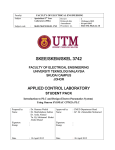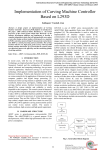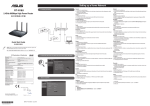Download UNIVERSITI TEKNOLOGI MALAYSIA
Transcript
PSZ 19:16 (Pind. 1/07) UNIVERSITI TEKNOLOGI MALAYSIA DECLARATION OF THESIS / UNDERGRADUATE PROJECT PAPER AND COPYRIGHT Author’s full name : ABDUL HANNAN BIN MOHD ZAHID Date of birth : OCTOBER 28TH 1988 Title : MULTIPLE SENSED DEVICE FOR DEAF PEOPLE Academic Session : 2011/2012 I declare that this thesis is classified as : CONFIDENTIAL (Contains confidential information under the Official Secret Act 1972)* RESTRICTED (Contains restricted information as specified by the organisation where research was done)* OPEN ACCESS I agree that my thesis to be published as online open access (full text) I acknowledged that Universiti Teknologi Malaysia reserves the right as follows: 1. The thesis is the property of Universiti Teknologi Malaysia. 2. The Library of Universiti Teknologi Malaysia has the right to make copies for the purpose of research only. 3. The Library has the right to make copies of the thesis for academic exchange. Certified by : SIGNATURE 881028-56-6421 (NEW IC NO. /PASSPORT NO.) Date : 29th JUNE 2012 NOTES : * SIGNATURE OF SUPERVISOR EN. MOHAMAD SHUKRI BIN ABDUL MANAF NAME OF SUPERVISOR Date : 29th JUNE 2012 If the thesis is CONFIDENTIAL or RESTRICTED, please attach with the letter from the organisation with period and reasons for confidentiality or restriction. ii “I hereby declare that I have read this thesis and in my opinion this thesis is sufficient in term of scope and quality for award of the degree of Bachelor of Engineering (Electrical – Control and Instrumentation)” Signature: Name of supervisor: Encik Mohamad Shukri bin Abdul Manaf Date: iii MULTIPLE SENSED DEVICE FOR DEAF PEOPLE ABDUL HANNAN BIN MOHD ZAHID A thesis submitted in fulfillment of the requirement for the award of the degree of Bachelor of Engineering (Electrical – Control and Instrumentation) Faculty of Electrical Engineering Universiti Teknologi Malaysia JUNE2012 iv I declare that this thesis entitled “ Multiple Sensed Device for Deaf People” is the result of my own research except as cite in the reference. The thesis has not been accepted for any degree and is not currently submitted in candidature of any degree. Signature : Name : ABDUL HANNAN MOHD ZAHID Date : v Specially dedicate to My beloved family, lecturers and friends who have guided and inspired me through my journey of education. Also to thank their support, beliefs and motivation. vi ACKNOWLEDGEMENT I would like to take this opportunity to express my greatest appreciation to my supervisor of this project, En Mohamad Shukri bin Abdul Manaf. I would like to thank him for his supervision, guidance and support during this project. Besides that, I would also like to thank my parents and family for giving me their support and encouragement throughout this project. Last but not least, also to my friends and those that have given me their support directly or indirectly. vii ABSTRACT A new method to help people with hearing problem to notify some of the changes in their surrounding by using sensors placed on certain area that will trigger a device attached to the person’s body. In this project we are using multiple sensors placed on certain spots in an area in order to detect any changes. For example the entrance door, a condenser microphone is attached to the door to detect knocks on the door. These knocks will trigger the RF transmitter. An RF receiver in the receiving device that is attached to the user will trigger a motor and vibrates hence alerting the user about the knocks. As a conclusion, the device can be an alternative for people with hearing impair to notice any changes that occur at allocated spots in an area. viii ABSTRAK Satu kaedah baru untuk membantu individu yang mempunyai masalah pendengaran untuk mendengar perubahan yang berlaku di sekeliling mereka dengan menggunakan beberapa sensor yang diletakkan di kawasan tertentu yang akan mengaktifkan satu peranti yang melekat pada badan pengguna. Projek ini akan menggunakan pelbagai sensor yang diletakkan pada tempat-tempat tertentu di sesuatu kawasan untuk mengesan sebarang perubahan. Sebagai contoh pintu dia mana satu mikrofon akan dilekatkan pada pintu untuk mengesan ketuakan pada pintu. Ketukan ini akan mengaktifkan pemancar RF. Penerima RF dalam peranti penerima yang berada di badan pengguna akan mengaktifkan motor dan menghasilkan getaran yang seterusnya akan memberi istarat kepada pengguna bahawa ada ketukan di pintu. Sebagai kesimpulan, peranti ini boleh menjadi satu alternatif bagi individu yang mempunyai masalah pendengeran untuk lebih peka dengan apa-apa perubahan yang berlaku di tempat-tempat yang diperuntukkan dalam sesuatu kawasan. ix TABLE OF CONTENTS CHAPTER 1 2 TITLE PAGE DECLARATION iv DEDICATION v ACKNOWLEDGEMENTS vi ABSTRACT vii ABSTRAK viii TABLE OF CONTENTS ix LIST OF TABLES xii LIST OF FIGURES xiii LIST OF SYMBOLS AND ABBREVIATIONS xv INTRODUCTION 1 1.1 Project Background 1 1.1.1 Deaf People 1 1.1.2 Deaf People’s Alertness 1 1.2 Problem Statement 2 1.3 Project Objectives 2 1.4 Project Scope 2 1.5 Aim of This Report 3 LITERATURE REVIEW 4 x 2.1 Current Reliable Product to Help Deaf People 4 2.1.1 Hearing Aid 4 2.1.1.1 The Application of Hearing Aid 4 2.1.1.2 Styles of Hearing Aids 5 2.1.1.2.1 Behind-the-ear (BTE) 6 2.1.1.2.2 In-the-ear (ITE) 6 2.1.1.2.3 Canal 7 2.1.2 3 Sonic Boom Alarm Clock (Model SB1000ss) 8 2.1.2.1 Overview SB100ss 8 2.1.2.2 Setting up the SB1000ss 9 2.1.2.3 Feature 9 2.1.2.4 Using the Alarm 10 RESEARCH METHODOLOGY 12 3.1 Concept of this project 12 3.2 Flow Chart 13 3.2.1 Hardware development 14 3.2.1.1 Hardware structure 14 3.2.1.1.1 Triggering circuits 14 3.2.1.1.2 Receiver device 16 3.2.1.2 Electronic components 17 3.2.1.2.1 17 Triggering circuits 3.2.1.2.1.1 RF transmitter 17 3.2.1.2.1.2 BC140 transistor 18 3.2.1.2.1.3 Encoder PT2262 18 3.2.1.2.1.4 Condenser 20 Microphone 3.2.1.2.2 Receiver device 20 3.2.1.2.2.1 RF receiver 20 3.2.1.2.2.2 Decoder PT2272-L4 21 3.2.1.2.2.3 Imbalance rotor DC 23 motor xi 3.2.2 4 5 Calibration and troubleshoot 23 3.2.2.1 Calibration 23 3.2.2.2 Troubleshoot 24 RESULT AND DISCUSSION 25 4.1 Microphone sensitivity 25 4.2 Volume input 27 4.3 Outputs 28 4.3.1 LED indicators 28 4.3.2 Vibrator 29 CONCLUSION 30 5.1 Conclusion 30 5.2 Weaknesses of project 31 5.3 Suggestions for future improvement 31 REFERENCES 33 APPENDICES APPENDIX A 34 APPENDIX B 35 xii LIST OF TABLES TABLES NO. TITLE PAGE 3-1 RF module specifications data 17 3-2 PT2262 pin description 18 3-3 Technical specifications of RF_RX_315 20 3-4 Pin description of decoder PT2272-L4 21 4-1 Output of the vibrator for each condition 28 A-1 FYP 1 Gant Chart 34 A-2 FYP 2 Gant Chart 34 xiii LIST OF FIGURES FIGURES NO. 2.1 TITLE Two types of BTE style hearing aid (a) Classic PAGE 6 BTE (b) “Mini” BTE 2.2 In-the-ear 6 2.3 Two types of canal style hearing aid (a) In-the- 7 canal (ITC) (b) Completely-in-canal (CIC) 2.4 The Sonic Boom Alarm Clock Model SB1000ss 8 2.5 Setting up the SB1000ss 9 2.6 Super Shaker™ Bed Vibrator - SS12VW 10 3.1 Multiple Sensed Device for Deaf People in action 11 3.2 Work Flow Chart 12 3.3 Triggering circuit using microphone 14 3.4 Triggering circuit using 3.5mm male audio jack 14 3.5 Triggering circuit using simple push button 14 3.6 Receiver device that will be attached to the user’s 15 body 3.7 Completed receiver device 15 3.8 The RF_TX_315MHz Type2 RF transmitter. 16 3.9 The BC140 transistor 17 3.10 (a) The PT2262 (b) The pin configuration 18 3.11 Condenser Microphone 19 3.12 The RF_RX_315Mhz 19 3.13 (a) PT2272-L4 (b) Pin configuration 20 3.14 Small imbalance rotor DC motor 22 4.1 Schematic circuit used on triggering circuit with 25 xiv microphone 4.2 (a) How the triggering circuit with microphone is 25 attached on surface (b) Placement of the microphone 4.3 Triggering circuit with microphone in action. (a) (b) Placement of the mi 26 Knocking on the surface the microphone is attached. (b) LED turns from OFF to ON when triggered by knocks 4.4 Schematic circuit used on triggering circuit with 26 3.5mm male audio jack 4.5 Connecting the triggering circuit with 3.5mm male 27 audio jack to an electronic device 4.6 LED turns from OFF to ON when triggered by 27 electrical signal from the audio output of device 4.7 LED indicators lit up according to which 28 triggering circuit is sending signal. From left, triggering circuit with microphone, triggering circuit with 3.5mm male audio jack, and simple push button 4.8 (a) Vibrator at OFF (b) Vibrator at ON 28 B.1 Connection for PT2272-L4 35 B.2 Connection for PT2262 35 xv LIST OF SYMBOLS AND ABBREVIATIONS BTE Behind-the-ear CIC Completely-in-canal DC Direct Current Hz Hertz ITC In-the-canal ITE In-the-ear LED Light Emitting Diode Mic Microphone RF Radio Frequency CHAPTER 1 INTRODUCTION 1.1 1.1.1 Project Background Deaf People The term Deaf with the capital “D” and deaf brings two different meaning. The term Deaf with the capital “D” refers to the community or culture of the deaf people while the term deaf refers to the symptom itself where deaf can be define as audiologic lack of hearing[1]. The membership of the deaf people community is not entirely populated by a deaf person. A person with normal hearing may have the membership. This may be due to they are the children of a deaf person and they learn the sign language as one of their primary language since a child. A deaf person also may not have the membership of a deaf community due to them still communicating verbally. 1.1.2 Deaf People’s Alertness Due to the lack of hearing ability, deaf people are less aware of the changes in their surrounding that they can’t see such as the ringing of a door bell and phones. To make up for this disadvantage that they are having, this project of inventing a 2 multiple sensed device for deaf people will take advantage of their skin and touch receptor to sense vibration that will trigger on these sounds or changes that will be detected by sensors. 1.2 Problem Statement In this modern world we are living, few ways have been invented to help deaf people to overcome their hearing weakness. Even though there are already several reliable devices to help them, these devices still have their own weaknesses such as the hearing aid can’t solve all level of deafness and some found it uncomfortable to wear. 1.3 Project Objectives There are several objectives for this project, which are: 1) To create a device that has multiple sensors placed around an area. 2) To assist deaf people using this device to gain more awareness of their surroundings. 1.4 Project Scope 1) In the designing process, three parts will be focused on: i) The sensors. ii) Transmitting the signal from the sensors to the receiving device. iii) The receiving device that will alert the user upon receiving signal from the sensors. 2) Will be focusing on implementing only three inputs. i) Temperature sensor 3 ii) Sound sensor 3) The device will be created to work in a small area such as a room. 1.5 Aim of This Report The aim of this report is to make the reader understands the purpose of this project, how it will be achieved and how it will help improve everyday lives of deaf people. CHAPTER 2 LITERATURE REVIEW In this chapter the review of other product that has been used to help deaf people today is covered in order to give an understanding to reader on how deafness can be overcome with the help of electronic devices. 2.1 2.1.1 Current Reliable Product to Help Deaf People Hearing Aid A hearing aid is a small electronic device that has three basic parts; the microphone, amplifier, and speaker. The hearing aid basically helps a deaf people by making sounds louder for the deaf person. 2.1.1.1 The Application of Hearing Aid The three basic parts of hearing aid has their own important role in order to help the deaf person. Hearing loss is caused by the lack of functioning small sensory cells in the inner ear called hair cells. The more hair cells damaged in the inner ear, the more severe the hearing loss is. 5 Hearing aids are worn inside or behind the ear depend on the style of the hearing aid. The first basic part of the hearing aid which is the microphone is also the first process of how the hearing aid functions. The microphone acts as a sensor of the deaf person’s surrounding. It detects surrounding sound and noises and sends it to the second basic part of the hearing aid, the amplifier. The amplifier functions like its name suggested, amplifying the sound and noises picked up by the microphone. The more hair cells in the inner ear are damaged, the more the amplifier needs to amplify the sound and noises for that person. The amplified sound and noises will then sent to the hair cells using a speaker. These remaining hair cells will detect the louder noise produced and send the signal to the deaf person. 2.1.1.2 Styles of Hearing Aids As mentioned before, hearing aids are worn inside or behind of the ear. The way that hearing aids are worn differs based on its design and style. There are three basic styles of hearing aids. 6 2.1.1.2.1 Behind-the-ear (BTE) Figure 2.1 Two types of BTE style hearing aid (a) Classic BTE (b) “Mini” BTE Figure 2.1 Two types of BTE style hearing aid (a) Classic BTE (b) “Mini” BTE shows two styles of BTE that we have today. These BTE are made of hard plastic case and as the name suggested, are worn behind the ear with an ear mold that fits inside the ear connected. The small electronic parts of the hearing aid are encased inside a small case attached behind the ear. BTE are suitable for people with mild to profound hearing loss. 2.1.1.2.2 In-the-ear (ITE) Figure 2.2 In-the-ear 7 Figure 2.2 In-the-ear shows the ITE hearing aid style. This hearing aid fits completely inside the ear of the wearer. The electronic parts also encased inside a hard plastic case. The ITE may also have an added feature called the telecoil. Telecoil is a small magnetic coil functions to detect signal through circuits instead of the microphone of the hearing aid. This is very useful to help the deaf person with telephone conversation for example. The ITE are not recommended for children due to the children’s ear is still in the growing stage. 2.1.1.2.3 Canal Figure 2.3 Two types of canal style hearing aid (a) In-the-canal (ITC) (b) Completely-in-canal (CIC) The canal style is very small and fits inside the wearer’s ear as shown in Figure 2.3 Two types of canal style hearing aid (a) In-the-canal (ITC) (b) Completely-in-canal (CIC). The CIC style is well hidden inside the wearer’s ear due to its small size. Both CIC and ITC are only suitable for person with mild to moderate severe hearing loss. This is because the small size has limited its battery capacity to supply a louder volume on the speaker. This style also not recommended for children due to children’s ear is still in a growing stage. 8 2.1.2 Sonic Boom Alarm Clock (Model SB1000ss) 2.1.2.1 Overview SB1000ss The SB1000ss is a specially designed alarm clock to help the deaf to wake up from the bed. It is designed so it can be used to all levels of severe of hearing impair. Like a normal alarm clock, it has all the normal features to show the time and let the user to set the alarm as they please. What makes it different is the SB1000ss has three significant extra features to help the deaf which are an extra-loud alarm system, a lamp connection port and a vibrator connection port. Figure 2.1 shows the SB1000ss. Figure 2.4 The Sonic Boom Alarm Clock Model SB1000ss 9 2.1.2.2 Setting up the SB1000ss Figure 2.5 Setting up the SB1000ss Figure 2.5 shows how the SB1000ss is set up in a bedroom. The SB100ss is connected with the bedside lamp and a vibrator which was placed under the bed sheet. The bedside lamp instead of connected directly to the power source, it is connected to the SB1000ss. The SB100ss is then connected directly to the home plug. The SB1000ss also has a 9V battery backup supply in order to retain the time and alarm settings in case of power failure[2]. 2.1.2.3 Feature As mentioned before, the SB1000ss has three significant features that will help the deaf. The first one is the extra-loud alarm system which is 113dB louder than normal sound. This sound can also be adjusted by the user in terms of its tone and volume. This function is suitable for a person who has minimal hearing impairment. The second feature which is the vibrator is suitable for those who have a more severe hearing impairment. The vibrator, a Super Shaker Bed Vibrator model SS12VW which also can be purchased separately used 12V of power supply. Figure 2.6 shows the SS12VW. Its power supply cord will be connected to the SB1000ss. There are two options the user can choose on how the user wants the SS12VW 10 vibrates. The first setting called STEADY means the vibrator will have a constant vibration when the alarm goes off. The second setting called PULSE will make the vibrator vibrates on and off when the alarm goes off. The user can freely choose between these two setting which is the most effective to wake them up[3]. Figure 2.6 Super Shaker™ Bed Vibrator - SS12VW The third feature is the ability to control the bed side lamp. The bedside lamp AC outlet will be connected to the SB1000ss. To use this feature, user must first ensure that the switch of the lamp is in the ON position. When the alarm goes off, it will automatically give supply to the lamp and turning it on. User can also manually turn on the lamp by pressing the large yellow LAMP button on the front of the SB1000ss. 2.1.2.4 Using the Alarm The SB1000ss has several waking options. These options will determine how the SB1000ss will react upon the alarm goes off. Like all the other alarm clock, the SB1000ss will require the user to set the clock and the alarm first. Then, the waking options can be set. The options are: 1) Audio alarm only 2) Flashing Light (with Audio On or Off) 3) Vibrator (with Audio On or Off) 4) Flashing light and Vibrator (with Audio On or Off) 11 Other than having the function of triggering the alarm using timer, the SB1000ss can also trigger its alarm using optional transmitters sold separately by the manufacturer. These optional transmitters for example are: 1) DS 700 Doorbell Signaler 2) TR 75 Telephone Signaler 3) BC 400 Baby Cry Signaler CHAPTER 3 RESEARCH METHODOLOGY This chapter discusses the concept of this project as the methodology used to design and fabricate the hardware structure, and electronic circuit. 3.1 Concept of this project The purpose of this project is to help deaf people to be more aware of their surroundings by taking advantage of their skin and touch receptor. The term multiple sensed used in the project title is realized by placing three circuits at different places in a small area. These circuits will be triggered using sound, signals or manually. By triggering these circuits, RF signal will be transmitted to an RF receiver attached to the user’s body and trigger a vibration to alert the user. Figure 3.1 Multiple Sensed Device for Deaf People in action 13 A situation example can be described based on Figure 3.1 Multiple Sensed Device for Deaf People in action. One of the circuit sensors is attached to the door as shown. The circuit is equipped with a microphone to detect any sound made on the door. Whenever sound is detected, it will trigger the RF transmitter and transmit RF signal. This RF signal will then picked up by a receiver attached to the user’s wrist and vibrates alerting the user. 3.2 Flow Chart Figure 3.2 shows the work flow chart of this project. Basically a work flow chart is how the project will be done shown step by step. Figure 3.2 Work Flow Chart The literature review on available relevant products is already covered in CHAPTER 2 of this thesis. In this chapter, discussion on the next steps will be covered. 14 3.2.1 Hardware development This sub topic explains the hardware structure of the triggering circuit and the receiver circuit. 3.2.1.1 Hardware structure 3.2.1.1.1 Triggering circuit There are three triggering circuit that were used in this project. All three are triggered differently. Figure 3.3 is one of the three triggering circuits that used a microphone to detect input. This circuit can be used to detect any sound made in the surrounding. This is the circuit that can be used to have the same effect as the example explained earlier in sub-topic 3.1. Another triggering circuit is shown in Figure 3.4. This circuit is using a 3.5mm male audio jack to detect any input. This circuit can be equipped on a computer or any electronic device such as phones to detect any sound signal. Unlike the others, the triggering circuit shown in Figure 3.5 is manually activated using a simple push button. This circuit is useful for anyone in the area wants to get attention from the deaf person. This circuit can also be implemented on a house doorbell system. 15 Figure 3.3 Triggering circuit using microphone. Figure 3.4 Triggering circuit using 3.5mm male audio jack Figure 3.5 Triggering circuit using simple push button 16 3.2.1.1.2 Receiver device Figure 3.6 Receiver device that will be attached to the user’s body The receiver device is the one that will be attached to the user’s body. It is equipped with a small imbalanced DC motor to generate vibration in order to alert the user that is wearing it. Figure 3.6 shows the receiver device in two parts. These two parts will then be connected using jumper wires and four PCB stands shown in Figure 3.7. Figure 3.7 Completed receiver device 17 3.2.1.2 Electronic components This sub-topic discusses the main electronic components used in this project. 3.2.1.2.1 Triggering circuits 3.2.1.2.1.1 RF transmitter (RF_TX_315MHz Type2) Figure 3.8 The RF_TX_315MHz Type2 RF transmitter. The RF_TX_315MHz Type2 is an RF transmitter produced by Cytron. Can be operated at 3V to 12V, this transmitter transmits 315MHz radio frequency at less or equal 10Kbps transfer rate and 25mW transmitting power if powered using 12V supply[4]. Using this RF module, the triggering circuits can send the triggered signal to the receiver device wirelessly. 18 No. 1. 2. 3. 4. 5. 6. 7. 8. 9. Specifications Operating Voltage Operating Current Oscillator Frequency Frequency error Modulation Transfer Rate Transmitting power Antenna Length RF Transmitter Module 3V to 12V Max ≤ 40mA (12V). Min ≤ 9mA (3V) SAW (Surface Acoustic Wave) oscillator 315MHz ~ 433.92MHz ± 150kHz (max) ASK/OOK ≤10Kbps 25mW (315MHz @ 12V) 24cm (315MHz). 18cm (433.92MHz) Table 3-1 RF module specifications data. 3.2.1.2.1.2 BC140 transistor Figure 3.9 The BC140 transistor Although it is a common electronic component, the BC140 plays a big role in the triggering circuit. This NPN silicon transistor acts as a switch that activates the triggering circuits when an input is detected[5]. 3.2.1.2.1.3 Encoder PT2262 The encoder PT2262 is a remote control encoder utilizing CMOS Technology[6]. Its pair, the decoder PT2272 is equipped on the receiving device to decode which triggering circuit is activated. Some of the features of this encoder are: 1. Low power consumption 2. Up to 6 data pins 3. Operates at Vcc = 4 ~ 15V 19 Figure 3.10 (a) The PT2262 (b) The pin configuration Pin Name I/O A0 ~ A5 I A6/D5, A7/D4 A8/D3 ~ A11/D0 I /TE I OSC1 O OSC2 I DOUT O Vcc Vss - Description Code Address Pin Nos.0 ~ 5 These six tri-state pins are detected by PT2262 to determine the encoded waveform bit 0 ~ bit 5. Each pin can be set to “0”, “1” or “f” (floating). Code Address Pin Nos.6 ~ 11/Data Pin Nos.5 ~ 0. These six tri-state pins are detected by PT2262 to determine the encoded waveform bit 6 ~ bit 11. When these pins are used as address pins, they can be set to “0”, “1”, or “f” (floating). When these pins are used as data pins, they can be set only to “0” or “1”. Transmission Enable. Active Low Signal. PT2262 outputs the encoded waveform to DOUT when this pin is pulled to low. A resistor connected Oscillator Pin No. 1 between these two pins determines the Oscillator Pin No. 2 fundamental frequency of the PT2262. Data Output Pin. The encoded waveform is serially outputted to this pin. When PT2262 is not transmitting, DOUT outputs low (Vss) voltage Positive Power Supply Negative Power Supply Table 3-2 PT2262 pin description Pin No. 1~6 7, 8 10 ~ 13 14 15 16 17 18 9 20 3.2.1.2.1.4 Condenser Microphone Figure 3.11 Condenser Microphone A small microphone used to detect any surrounding sound. This microphone is equipped to one of the triggering circuit. 3.2.1.2.2 Receiver device 3.2.1.2.2.1 RF receiver (RF_RX_315Mhz) Figure 3.12 The RF_RX_315Mhz The RF_RX_315Mhz is an RF receiver. It detects any RF signal transmitted via the RF_TX_315MHz Type2 from any of the triggering circuits. Like its pair, this receiver also produced by Cytron. The RF_RX_315Mhz is operated at 5.0V ± 0.5V 21 using monolithic super heterodyne receiving operating principle. More of its technical specifications can be known by referring No. 1. 2. 3. 4. 5. 6. 7. 8. 9. 10. Specifications Operating Voltage Operating Current Operating Principle Modulation Frequency Bandwidth Sensitivity Rate Data output Antenna Length RF Receiver 5.0V ± 0.5V ≤5.5mA @ 5.0V Monolithic super heterodyne receiving OOK/ASK 315MHz, 433.92MHz 2MHz -100dBm < 9.6Kbps (315MHz @ -95dBm) TTL 24cm Table 3-3 Technical specifications of RF_RX_315 3.2.1.2.2.2 Decoder PT2272-L4 Figure 3.13 (a) PT2272-L4 (b) Pin configuration The remote control decoder PT2272-L4 uses the same CMOS technology as the encoder PT2262[7]. These two encoder and decoder will be paired with each other in order to determine which triggering circuit is sending signal to the receiver device. 22 Pin Name A0 ~ A5 I/O I Desciption Code Address Pin Nos. 0 ~ 5. These six tri-state pins are detected by PT2272 to determine the encoded waveform bit 0 ~ bit 5. Each pin can be set to “0”, “1”, or “f” (floating). Pin No. 1~6 Code Address Pin Nos. 6 ~ 11/Data Pin Nos. 5 ~ 0. These six pins are used as higher address input bits or data output pins depending on the version (type) of PT2272 used. When used as address inputs, these pins are tri-state input pins and each pin can be set to “0”, “1”, or “f” (floating). When used as output pins, these pins are driven to VCC if (1) the address decoded from the waveform that was received matches the address setting at the address input pins, and (2) the corresponding data bits received is a “1” bit. Otherwise, they are driven to VSS. A6/D5 ~ A11/D0 I/O DIN I Data Input Pin. The encoded waveform received is serially fed to PT2272 at this pin. OSC 1 I Oscillator Pin No. 1 OSC 2 O Oscillator Pin No. 2 VT O VCC VSS - A resistor connected between these two pins determines the fundamental frequency of PT2272. Valid Transmission. Active High Signal. VT in high state signifies that PT2272 receives valid transmission waveform Positive Power Supply Negative Power Supply Table 3-4 Pin description of decoder PT2272-L4 14 15 16 17 18 9 23 3.2.1.2.2.3 Imbalance rotor DC motor Figure 3.14 Small imbalance rotor DC motor The imbalance rotor DC motor is a common mechanism used to generate vibration in mobile phones. The DC motor used is small and can be operated low voltage. The motor needs to be placed as close as possible to the circuit board in order to get the most of the vibration it created when it spins. 3.2.2 Calibration and troubleshoot Calibration and troubleshoot the hardware is to ensure that the hardware is working as intended. 3.2.2.1 Calibration The sensitivity of the triggering circuits needs to be calibrated in order for them to be able to easily detect signals that they need to. For example, if the triggering circuit using microphone is assigned to detect door knocks, the sensitivity of the circuit needs to be adjusted so that it will be easy to be triggered by door knocks but not too sensitive so that the circuit won’t be triggered by other sound made at the door’s surrounding. 24 The same thing also applied to the triggering circuit using 3.5mm male audio jack. The sensitivity of this circuit also needs to be calibrated so that only a specific sound at a specific volume will be detected to trigger the circuit. The calibration for both of these triggering circuits can be made by changing the value of resistor that is used for biasing one of the amplifying transistors in the circuits. The bigger the value of the resistor is, the less sensitive it gets. 3.2.2.2 Troubleshoot In the troubleshoot process, the circuits will be tested whether they are functioning as intended or not. The troubleshoot process begins by testing the triggering circuit whether the input signal is able to trigger the circuit or not. Troubleshoot will commence if the input signal does not triggered the circuit. The next step of this process is to check whether the RF signal transmitted by the triggering circuit is received by the RF receiver at the receiving device or not. While at it, the data received at the receiver also was checked whether or not it matches the data sent by the triggering circuit. The final step of this process is to test the receiving device. The test is successful if the vibrator and LED indicator at the receiving device can be triggered using RF signal sent by the triggering circuit or not. Chapter 4 RESULT AND DISCUSSION The objective of this project is to create a device that can help the deaf people to gain more awareness of what they can’t see in a small area. In order to find out whether or not the objective is achieved, several experiments on how the device performed was done to observe the response of the device. 4.1 Microphone sensitivity This experiment was conducted in order to ensure the triggering circuit with microphone was calibrated to have the sensitivity needed to be triggered by simple knocks on where the circuit will be attached. Based on Figure 4.1, resistor R1 was adjusted in order to calibrate the sensitivity of the circuit. After few try and error adjustments, the value of R1 needed was found to be 270kΩ in order to get the necessary sensitivity. 26 Figure 4.1 Schematic circuit used on triggering circuit with microphone Figure 4.2 (a) How the triggering circuit with microphone is attached on surface (b) Placement of the microphone 27 Figure 4.3 Triggering circuit with microphone in action. (a) Knocking on the surface the microphone is attached. (b) LED turns from OFF to ON when triggered by knocks 4.2 Volume input Figure 4.4 Schematic circuit used on triggering circuit with 3.5mm male audio jack Another triggering circuit that needs to be calibrated in order to have the sensitivity needed is the triggering circuit with 3.5mm male audio jack. The same circuit shown in Figure 4.1 was used to create this triggering circuit. 28 The voltage output of the audio jack of a device is not absolutely zero even when no sound was made. There’s noise output that needs to be compensate so that the triggering circuit does not triggers needlessly. After a few try and error adjustments, the value of R1 needed was found to be 47kΩ for this triggering circuit making the circuit to look like shown in Figure 4.4. Figure 4.5 Connecting the triggering circuit with 3.5mm male audio jack to an electronic device Figure 4.6 LED turns from OFF to ON when triggered by electrical signal from the audio output of device 4.3 4.3.1 Outputs LED indicators In order to know which of the triggering circuit is triggered, each of the triggering circuit has its own LED indicator assigned to each of them placed on the receiver device. Whenever a triggering circuit is triggered, a specific LED will lit up to show the user from where the signal came from. 29 Figure 4.7 LED indicators lit up according to which triggering circuit is sending signal. From left, triggering circuit with microphone, triggering circuit with 3.5mm male audio jack, and simple push button 4.3.2 Vibrator The vibrator is actually the most crucial output part of this project. The vibrator will be used to alert the user whenever a triggering circuit is triggered. There are no specific outputs of the vibrator for each triggering circuit. Hence, the condition of the vibrator is only two which are, Condition No signal received Signal received Output OFF ON Table 4-1 Output of the vibrator for each condition Figure 4.8 (a) Vibrator at OFF (b) Vibrator at ON CHAPTER 5 CONCLUSION This chapter concludes the research and development of this multiple sensed device for deaf people project. Some of the weakness of this project and how to improve it is also included in this chapter. 5.1 Conclusion The objective of this project is to help deaf people to gain more awareness of their surroundings. The scope of this project is to cover only a small area such as an apartment or a small room. There are already effective devices to help a deaf person not only to gain awareness but also to help them hear like normal people does. But, to certain deaf people, they are not very comfortable with the existing device such as the hearing aid. Hence, this multiple sensed device for deaf people can act as an alternative for these people. After various tests and experiments, the multiple sensed device for deaf people is not only achieved its objective to help deaf person to gain more awareness of their surroundings, but also comfortable to wear to most people with wristwatch. Hence, it can be an alternative to help deaf people to be more aware of their surroundings. 31 5.2 Weaknesses of Project There are a few weaknesses the final product has. The main weakness that anyone can see instantly is that the size of the receiving device is quite large. This makes it not that comfortable to wear and is not mobile enough for the user to wear. One of the main concern while designing the circuit is the amount of RF signal that will be sent by the same frequency during the exhibition. Hence the big circuit design by implementing switches to set the address of the decoder and encoder to ensure that no signal from other RF transmitter will trigger the receiving device. Other weakness is the power of the vibrator. The motor used is actually the same motor used by mobile phone to generate vibration. The weak power of the vibrator may be caused by the weak power provided by the battery source and how the circuit board the vibrator attached to has absorbed the vibration making it less powerful. 5.3 Suggestions for Future Improvement One of the main future improvements that can be made is to design a smaller and compact circuit for the receiving device to make it more comfortable and mobile for the user. This can be achieved by redesign the circuit by removing the switches used to set the addressing of the decoder. Also, the usage of Printed Circuit Board to make the circuit will help improve the size of the circuit. The receiving device should be as small as the conventional wrist watch we have today. More functions can be added to the receiving device such as an alarm that can be set to trigger the receiving device. The user can set at what time the receiving device will be triggered. When the time comes, the vibrator will be triggered. Think of this as an alarm watch feature for deaf people. 32 Another future improvement that can be made is to integrate this system to a mobile phone. Nowadays, programs for mobile phones can be written easily. The idea is to write a program that will trigger the vibrator of the mobile phone whenever one of the triggering circuits detects any changes in the surrounding. Instead of using RF, in this application, Bluetooth signal will be used. REFERENCES [1] S. Barnett, "Clinical and cultural issues in caring for deaf people," FAMILY MEDICINE-KANSAS CITY-, vol. 31, pp. 17-22, 1999. [2] S. Alert, "Alarm Clock with Super Shaker - SB1000ss [online]." [3] S. Alert, "Sonic Boom Alarm Clock Model SB 1000 Instruction Manual." [4] C. Technologies, "RF Transmitter Module: User's Manual," vol. V1.1, p. 8, November 2008 2008. [5] M. E. LTD., "BC140, BC141 datasheet." [6] P. T. Corp., "Remote Control Encoder PT2262 Datasheet," September 2008 2008. [7] P. T. Corp, "Remote Control Decoder PT2272 Datasheet," June 2008 2008. 34 APPENDICES APPENDIX A Gant chart Table A-1 FYP 1 Gant Chart Table A-2 FYP 2 Gantt Chart 35 APPENDIX B Schematic circuit diagram Figure B.1 Connection for PT2272-L4 Figure B.2 Connection for PT2262







































































